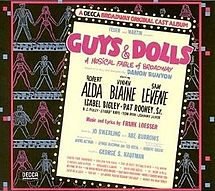
From Broadway To 52nd Street
The music composed for Guys & Dolls by Frank Loesser was first heard on the stage at the 46th Street Theatre on January 24, 1950. It became a part of the blockbuster club with a total of 1200 performances. The show starred Robert Alda, Sam Levene and Vivian Blaine, the latter who would go on to star in the 1955 movie version with Frank Sinatra, Marlon Brando, Jean Simmons and Stubby Kaye. Coming out of the play into jazz prominence were the songs If I Were A Bell, I’ll Know, I’ve Never Been In Love Before and Luck Be A Lady Tonight.
The Story: New York gambler, Nathan Detroit, tries to set up a floating crap game since the highest of the high rollers, Sky Masterson, is in town. All the while the police are putting on the heat to prevent the game from happening. Nathan bets Sky that he cannot woo any girl he chooses. He picks Salvation Army’s Sister Sarah and off to Cuba she and Sky go. Ultimately the game takes place in the empty Salvation Army headquarters. Nathan has promised his girl Adelaide that he has quit gambling and will marry her. Romance ensues for all and both Nathan and Sky marry in the end.
Although Guys and Dolls was selected as the winner of the 1951 Pulitzer Prize for Drama, the prize was not awarded because writer Abe Burrows was being investigated by the House Un-American Activities Committee. Do to these troubles with HUAC, the Trustees of Columbia University vetoed the selection, and no Pulitzer for Drama was awarded that year.
Jazz History: In 1950, Charlie Parker, despite a severe drug problem, was at the height of his career. It was during that same year that he became the first jazz musician to record with a string ensemble, which produced the album Charlie Parker With Strings. The year also saw the beginning point were a series of singles on Capitol Records of a nonet led by trumpeter Miles Davis, collected and released first on a ten-inch and later a twelve-inch as the Birth of the Cool. Cool jazz recordings by Chet Baker, Dave Brubeck, Bill Evans, Gil Evans, Stan Getz and the Modern Jazz Quartet usually have a “lighter” sound that avoided the aggressive tempos and harmonic abstraction of bebop. Cool jazz later became strongly identified with the West Coast jazz scene, but also had a particular resonance in Europe, especially Scandinavia, with emergence of such major figures as baritone saxophonist Lars Gullin and pianist Bengt Hallberg. However, blind Chicago pianist Lennie Tristano set out the theoretical underpinnings of cool jazz. Its influence stretches into such later developments as bossa nova, modal jazz, and even free jazz.
Sponsored By
www.whatissuitetabu.com


